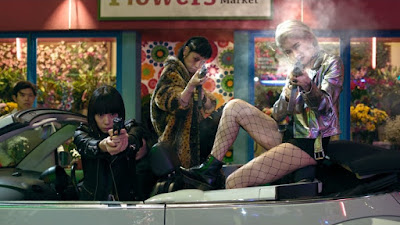Although Sono previously made the Japanese television series Minna! ESPer Dayo!, that was more of a work for hire that didn't have Sono's usual artistic flair. Tokyo Vampire Hotel is a much more personal and original project for Sono. Like Noriko's Dinner Table and Love Exposure, Tokyo Vampire Hotel involves a secret cult who recruits those from the outside world to offer them a form of salvation. As Tokyo Vampire Hotel begins, a young woman named Manami (Ami Tomite) is targeted by two groups of vampires, the Dracula and the Corvin clans, who each want to abduct her to help her harnass her untapped vampiric powers. Eventually, the vampire Yamada (Shinnosuke Mitsushima) of the Corvin clan captures Manami and brings her to the palatial Requiem Hotel, where he intends to imprison Manami and a large group of other innocent people in order to help himself and his partner Elizabeth Bathory (Megumi Kagurazaka) achieve nefarious goals. In the meantime, the vampire K (Kaho) of the Dracula clan races against time to try to rescue Manami from the Corvin clan.
This plot summary makes Tokyo Vampire Hotel sound like a typical horror story, but Sion Sono embues the series with all kinds of surrealist and eccentric touches which elevate it beyond the genre. Admittedly, some of the more traditional gothic elements in the opening episodes border on vampire lore cliches, especially the scenes set in Transylvania. But, once Sono moves the story arc to the Hotel Requiem, he is back in his usual subversive terrain. The scenes of unflinching torture and depravity that Yamada inflicts on his prisoners in the hotel at times recalls Pier Paolo Pasolini notorious Salo, or the 120 Days of Sodom. Like Salo, Tokyo Vampire Hotel explores the dark depths of human cruelty and brutality, a theme which Sono himself has depitced in previous films like Strange Circus and Antiporno.
Much of Tokyo Vampire Hotel takes place in the Hotel Requiem, and the set design of the location is astonishing in both its aesthetic glamor as well as its more grotesque elements. The scenes where Elizabeth Bathory's pulsating body starts to merge with the very structure and architecture of the hotel itself reminds one of the body-horror films of David Cronenberg, as the barriers between the flesh and artifically created environments form a new alternately repuslive yet strangely alluring whole. Once you make it past the more traditional first few episodes, you'll discover Sion Sono in all his usual taboo destroying glory.
Another common theme in Sion Sono's later work is the battle between love and hate, or light and darkness. Many of Sono's earlier films were nihilistic portrayals of human nature, with virtually no hint of redemption or optimism. This is best exemplified by his darkest film Strange Circus, which was an almost non-stop barrage of images of torture and pain. With Love Exposure, Sono seemed to turn a corner in his career, as for the first time he made a film which, despite its many scenes of violence and brutality, had a strong undercurrent of blissful hope. Sono would return to his more despairing tone in subsequent films like Himizu and Why Don't You Play in Hell?, but even those films had a hint of faith in humankind.
With Tokyo Vampire Hotel, Sono balances out the earlier scenes of vile human behavior with later episodes that explore lightness overcoming darkness. The former scenes of innocent people being tortured and killed in the Hotel Requiem are replaced with a new society of vampires and humans living in peace and harmony with each other. The cult of the vampires based upon exploitation over others is now an altruistic group whose core values are the peace and well-being of the community, similar in a way to the Zero Church cult in Love Exposure.
While Love Exposure signaled Sono's evolution from a prince of nihilism to a more benign filmmaker, Sono still has maintained his subversive edge, as evidenced by his decision to not shirk from exploring the darker depths of the human soul in Tokyo Vampire Hotel. One can say that Sono is a more developed artist now, because he has found a way to balance out the unyielding cynicism of his earlier films with more sanguine themes. Sono has always been fascinated in exploring the lives of outsiders who commit criminal acts, from serial killers, to con-men, to gangsters, but now he is equally intereted in portarying characters who dwell in more harmonious waters. Ultimately, Tokyo Vampire Hotel is about a battle for the soul of an innocent woman, and this time lightness may actually overcome darkness.





No comments:
Post a Comment